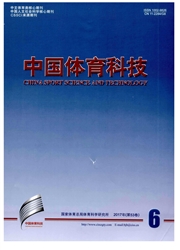

 中文摘要:
中文摘要:
目的:比较西藏自治区世居藏族青年男女BMI分层的检出率;研究该人群BMI对身体机能和素质指标的影响;分析BMI与身体机能和素质指标的相关性。方法:研究对象:3 206名19-44岁西藏自治区世居藏族青年;测试指标:身体形态指标:身高(cm)、体重(kg);身体机能指标:肺活量(ml)、台阶指数、收缩压(mmHg)、舒张压(mmHg)和心率(次/min);身体素质指标:选择反应时(s)、坐位体前屈(cm)、握力(kg)和闭眼单脚站立(s)。派生指标:BMI(kg/m2)、肺活量体重指数、脉压(mmHg)和握力体重指数。按分类标准将BMI分为4组:体重偏轻、体重正常、超重和肥胖。统计学方法:Descriptive Statistics,Explore,Histogram,Pearsonχ2,One-Way ANOVA和Partial Correlations。结果:西藏自治区世居藏族青年平均BMI为22.96±3.12kg/m2,男子为23.28±3.21kg/m2,女子为22.55±2.98kg/m2;在3 206名受试者中,体重偏轻者158人,体重正常者1 964人,超重者869人,肥胖者215人。男、女之间体重偏轻组的检出率差异无统计学意义(P〉0.05);体重正常组、超重组和肥胖组检出率差异均有统计学意义(P〈0.01)。BMI分层不同,男、女身体机能指标:肺活量、肺活量体重指数、台阶指数、收缩压、舒张压、脉压和男子心率差异均有统计学意义(P〈0.05),女子心率差异无统计学意义(P〉0.05);男女身体素质指标:选择反应时、坐位体前屈、握力、握力体重指数差异均有统计学意义(P〈0.05),闭眼单脚站立差异无统计学意义(P〉0.05)。将性别和年龄设为控制变量,BMI与体质指标偏相关分析结果:BMI与肺活量、收缩压、舒张压、脉压和握力呈正相关(P〈0.01),与肺活量体重指数、台阶指数、选择反应时、坐位体前屈和握力体重指数呈负相关(P〈0.01),与心率和闭眼单脚站立不相关(P〉0.05)。结论:1)西藏自治?
 英文摘要:
英文摘要:
Objective:This study compares the BMI layered detection rate of native young man and woman in the Tibet Autonomous Region.To study the influence on physical function and physical fitness index based on their BMI,and to analyze the relativity between BMI with physical function and fitness index.Methods:The research is targeted at 3206 young people at the age of 19-44of Tibetan nationality in the Tibet Autonomous Region.Testing index:The body shape index include Height(cm),Weight(kg).The physical function index include vital capacity(ml),systolic pressure(mmHg),diastolic pressure(mmHg)and heart rate(times/min).The physical fitness index include choice reaction time(s),set and reach(cm),grip strength(kg)and eye-closed and single-legged standing(s).Derive index:BMI(kg/m2),the index of vital capacity,pulse pressure(mmHg)and the index of grip strength.BMI is divided into four grades:underweight,normal,overweight and obesity.Statistics method include:Descriptive Statistics,Explore,Histogram,Pearsonχ2,One-Way ANOVA and Partial Correlations.Results:The average BMI index of native youth in the Tibet Autonomous Region is22.96±3.12kg/m2,among that the male's BMI index is 23.28±3.21kg/m2,while the female's BMI index is 22.55±2.98kg/m2.Of all 3206 people enrolled in the study,there are158 underweight people,1964 normal weight people,869 overweight people,and 215 obesity people.The different detection rate of underweight between male and female was statistically insignificant(P〈0.05),the different detection rate of the normal group,overweight and obesity group were statistically significant(P〈0.01).The physical function index for male and female under the different layering of BMI are:vital capacity,the index of vital capacity,step test,systolic pressure,diastolic pressure,pulse pressure and male heart rate differences were statistically significant(P〈0.05).The differences of heart rate for female was statistically insignificant(P〈0.05
 同期刊论文项目
同期刊论文项目
 同项目期刊论文
同项目期刊论文
 期刊信息
期刊信息
